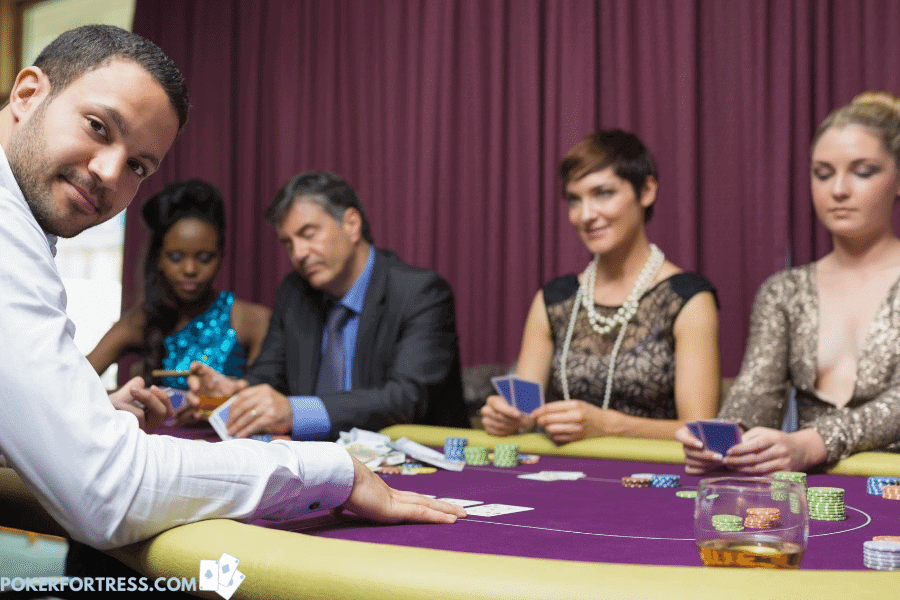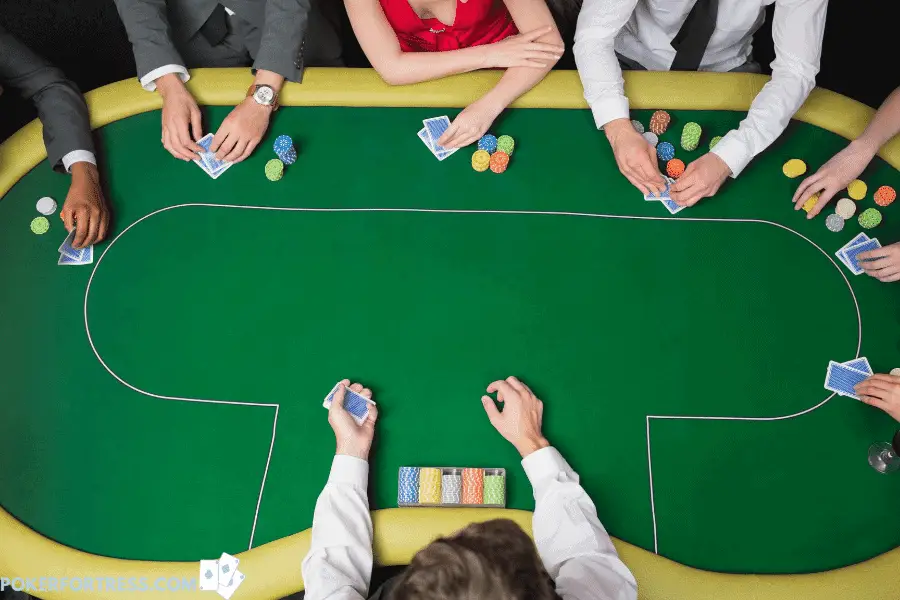In poker, a burned card is a card that is dealt from the top of a deck but is unused or discarded by the dealer. If you’re making the transition from live to online poker, you may find the burned card tradition a little weird. Why do poker dealers discard cards from the top of a deck? Let’s find out.
Why do poker dealers burn cards? The main reason poker dealers burn cards is to prevent cheating. This type of cheating is usually perpetrated via marked cards. Players may be able to identify the top card if it has a mark or a folded edge.
When dealers burn the top cards, they effectively eliminate any chance of players identifying a card and gaining an unfair advantage in a hand.
Casinos hire professional dealers who are experienced in dealing cards. But if home games don’t have exclusive dealers, players will have to take turns to act as dealers. This is why every poker player needs to have an idea on the correct way to deal cards in Texas hold ’em.

Why do Dealers Burn Card?
The purpose of a burned card is to prevent card marking that may lead to cheating, but that’s not all. Here are other benefits of the burn card.
- To Rectify Irregularities: Burn cards are used to replace any card that is turned over by mistake when the cards are being dealt. The dealer is expected to remove that card and use it as the burn card for the flop. The player who was to be dealt with that card will be given a replacement when other cards have been distributed. However, if players are being given blinds and a card happens to be turned over or flashed, a misdeal will be announced and the cards will be reshuffled.
- To Counter Second Dealing: This is another measure to prevent another type of cheating known as second dealing. This happens when a player knows the value of the top card and instead chooses to deal with the second card. Second dealing increases the player’s odds of winning by affording them more than one chance at making their hand.
The Tradition of Burn Cards
Burning is not exclusive to poker. It’s a tradition that’s associated with most card games. It originated from the brick and mortar casinos mainly as a way to prevent cheating via card markings. It was noted that some players were able to identify cards on top of a deck with knowledge from the previous rounds.
To ensure there remains a level playing ground, the top cards are burned before each betting round. When you burn a card, it’s placed face down and out of play.
A burned card can no longer be used in subsequent betting rounds until the hand has ended.
The term ”burned cards” literally means the card is no longer in play. It is worthy of note that the dealer doesn’t burn a card pre-flop.
Immediately the deck is cut; the first card on top of the deck is dealt. Cards can only be burned before dealing in subsequent betting rounds (flop, turn, and river). This means only 3 cards can be burned during a hand.
How to Deal Cards in Texas Hold ’em
Sometimes, people tend to burn cards incorrectly. This is usually due to their inability to deal cards properly. Whether you’re playing in a casino or at home with friends, follow this few steps routine to deal cards correctly.
- Shuffle: Once the card is in the hands of the dealer, the first step is to shuffle. To shuffle, the card can be split in half, smooshed, or riffled. However, most casinos use shuffling machines to get accurate shuffle.
- The Cut: After shuffling, the deck is split into two with the bottom half placed on top of the top half. In many games, the card is cut by the player to the dealer’s right. In most casinos, however, the dealer makes the cut.
- The Deal: The card is dealt in a clockwise direction around the table. The dealing starts with the small blind who is on the dealer’s left. The first betting round (pre-flop) starts with each player getting 2 cards each. After the pre-flop round, the dealer burns a card and places it faces down on the table.
- Flop: After burning a card, the dealer deals 3 community cards on the table with all three turned over. These three cards are called the flop, and a round of betting follows immediately they are dealt. When the flop round is concluded, the dealer burns another card and deals with another community card flipped over.
- Turn and River: The flipped card is called the turn, and another round of betting follows. When the action on the turn closes, the dealer burns the last card and deals with the final community card called the river. This brings the total of burned cards to 3 in 4 betting rounds. In Texas hold’em, only 3 burn cards are allowed.
Do Burn Cards Affect Probability?
Burned cards do not affect probabilities. Probabilities are determined by known and unknown cards. Unknown cards, whether they are in the hands of another player or the burn pile, eventually cancel out other unknown cards, so they do not affect the probabilities.

The only way a burn card can affect probabilities is if it is somehow exposed, then the odds can be changed.
What Happens to the Burned Card?
When a dealer burns a card, it’s assumed that the card is not in play. Burned cards can be placed anywhere on the table as long as it’s not on the deck. Also, burned cards cannot be placed in the muck as this would make it difficult to determine the number of burned cards during a hand. It also helps the dealer and players determine which betting round is in progress.
Sometimes, a dealer may forget to burn a card. In that case, a decision is made depending on whether a bet has been made. If action has already closed in the betting round, then the action must go on. In case a bet hasn’t been made, a new card is dealt, and the card that ought to be the burn card is put aside. The casino floor is called to intervene should any disputes arise regarding whether a card is burned or not.
In home games with friends or family, a mutual agreement is reached, and the action continues. The offending card can be put back into the undealt card and the deck reshuffled. The action can then continue as normal.
Conclusion
Although card marking is no longer prominent in modern poker, the burn card tradition is still very much present in live poker. However, this type of cheating has never been possible in online poker, and as such, burning cards would be unnecessary. If you do play live poker, it’s essential to learn how to burn cards properly as it may come in handy if you ever have to act as a dealer in a home game.
Related Questions
Can you play poker without burning a card? Yes, you can. The burned card tradition might be popular in live poker; it doesn’t necessarily affect the game in a significant way.
Can anyone else burn cards apart from dealers? In a game that has a designated dealer, he/she can burn cards. However, in games where a professional dealer is not available, each player will need to act as a dealer and deal cards accordingly when it gets to their turn. A card can only be burned by a dealer, whether professional or player.



